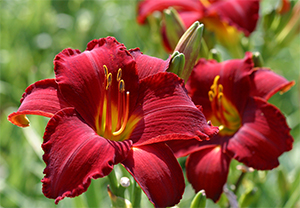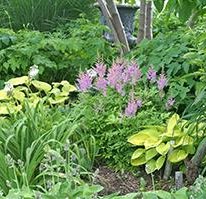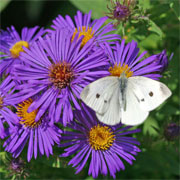 |
| Daylily 'Dunrobin' |
All Daylilies
ON SALE
NOW!
20% OFF
Both potted daylilies and bare root orders!
Choose from more than 80 different varieties of daylilies in pots. If you don't see what you like in pots, pick up a copy of our Daylily List and wander through the display gardens. Mark the ones you like and then place an order in our garden center or over the phone. We will dig them fresh for you and your daylilies can be picked up at our garden center or we can ship them right to you.
Can't make it to Viette's during
daylily time?
No worries!
Simply browse our complete
Daylily Catalog and
visit the
daylily photo galleries on our website. It's
almost as good as being here (but not really!)
Choose the ones you want and give us a call
at 800-575-5538.
We will be happy to take your order and give you the
20% discount!
Your daylilies can be shipped to you or you can pick them up here.
|
| Plant of the Month |
|
|
| Hibiscus x 'Lord Baltimore' in Andre's front garden |
Hibiscus moscheutos
Marsh Rose
Mallow
Huge
& Hardy
Wandering through André's gardens in late July, you can't help but be impressed by the awesome display of magnificent flowers produced by the marsh rose mallow,
Hibiscus x 'Lord Baltimore'. These huge brilliant red flowers are every bit of 10" across! The large pink blooms of
Hibiscus x 'Lady Baltimore' put on an equally impressive show in André's gardens. These hardy perennials make a bold statement in the garden and are a stunning focal point at this time of year.
|
|
|
Hibiscus 'Lady Baltimore'
|
A Great Addition
Hibiscus moscheutos, commonly known as the marsh rose mallow or just rose mallow, is a winter hardy shrubby perennial that grows from 3 feet to 6 feet tall and is hardy in Zones 5 to 9. They are fast growing and prefer full sun or bright shade to perform and bloom to their full potential. They love having their feet wet so the edge of a pond or a boggy area in your yard is the perfect place for these beauties. Wet soil is not a necessity, however, and Hibiscus will do very well in any rich well-drained garden soil. In any case, because of their size, it is best to plant them towards the back of the border garden or in the center of an island bed.
In the early spring, cut the previous year's stems right to the ground. New growth will appear in the late spring. These perennials break dormancy late so don't worry when you don't see new growth right away in the spring! To keep the plant more compact, you can cut the new stems by about half when they reach 18" tall.
|
|
| Hibiscus 'Lord Baltimore' |
Lots of Variety!
There are many wonderful hardy hibiscus cultivars to choose from. They range in color from the brilliant red Hibiscus x 'Lord Baltimore' to the beautiful pink Hibiscus x 'Lady Baltimore'.
Another interesting variety is Hibiscus 'Kopper King'. This beautiful cultivar has unique burgundy foliage that matures to a rich copper in the fall. The striking light pink flowers have a deep red center with red veining that radiates out into the flower petals. What a fantastic contrast in colors!
|
|
|
Hibiscus 'Kopper King' is a spectacular hibiscus.
|
'Chablis' is a beautiful white variety with a small bright pink center. This variety will make a striking addition to any sunny garden!
More than just big flowers
Individual hibiscus flowers are short-lived but each plant puts up many stems and each stem produces many buds, so the bloom goes on for quite a long time! But even when the flowers are gone, Hibiscus are still in the limelight. The foliage remains attractive through the season, turning a beautiful yellow in the cool fall air. Even the seed pods which form after the bloom are attractive and can add interest to dried arrangements.
Hibiscus syriacus
Better known as
Rose of Sharon or shrub althea, this upright, deciduous, woody shrub hibiscus is an old-fashioned favorite. It bears a profusion of flowers from July all the way through September.
|
|
| Hibiscus syriacus 'Blue Bird' |
'Blue Bird' has beautiful lavender-blue flowers and is quite striking in the garden. It self-seeds readily but the seedlings do not usually produce flowers with the same blue color as the parent. 'Diana' is a white flowered cultivar which is sterile and will not self-seed in the garden.
Rose of Sharon grows and blooms best in a location that receives full sun and has well drained soil. This shrub is drought tolerant once established in the garden. Flowers are produced on new wood so pruning should be done in the early spring before they break dormancy.
Rose of Sharon is deer resistant and also grows under black walnut trees!
|
If you enjoy our newsletter, please pass it along to your gardening friends!
|
|
Join Our List
|

|
| Gardening Questions? |
Listen to Andre
on the radio every Saturday morning from 8:00-11:00 on
"In the Garden
with Andre Viette"
|
Viette Discussion Board
|
Having trouble
getting through on
the radio?
Visit our
Discussion Board for answers to your gardening questions. Use the convenient search key to see if we have already addressed your problem!
Don't see the answer? Post your question!
It's EASY, just register
as a member.
Please provide your city and state so we are better able answer your question.
|
|
|
|
Tip of the Month
|
|
|
| Buddleia are drought tolerant and will attract butterflies to the summer garden |
Water-wise Gardening!
Xeriscaping with drought tolerant plants ...
|
|
|
A honey bee collects nectar and pollen from a sunflower
|
Recently, we have not been able to listen to the news without hearing about the drought conditions in California and other areas across the US. Many say, "Welcome to the "New Normal." Water conservation is on everyone's minds these days, yet our gardens provide the flowers needed by our butterflies and bees, and provide us with a place of tranquility after a hard day at work. So what can we do? How can we have the beauty of the garden, yet not feel that we are wasting a precious resource?
Not a New Problem
Xeriscaping is a water-wise approach to gardening that was developed over 30 years ago for the arid regions of the western United States. In the east, a modified version of xeriscaping can be used to conserve water during times of drought. It brings seven principles into play in the development and maintenance of your landscape.
Have a Plan!
Group plants based on drought tolerance. Choose drought tolerant plants for the sunniest areas of your landscape. Plants with greater moisture requirements should be planted in semi-shade or perhaps closer to the house or another water source.
Choose Your Plants Carefully
|
|
|
New cultivars of the native
purple coneflower (Echinacea) provide a wide variety of colors
|
A few water-loving plants are fine, but place them close to the house and water. For gardens farther from a water source, native and introduced plants that thrive in dry conditions are best. There are many wonderful drought tolerant shrubs and perennials available for your full sun and shady gardens. These are mainly native species that have been hybridized into gorgeous cultivars. Some of these plants are drought tolerant once established, so you may need to water them at first, but gradually you can cut back.
Improve Your Soil
The more organic material you can work into the soil the better its moisture retention will be. Amend the soil before planting and use an organic mulch.
Organic mulch not only shades the soil and reduces evaporation by lowering the surface temperature, it also breaks down adding much needed organic matter to the soil. A three-inch layer of mulch is recommended when starting beds, and a yearly addition if needed goes a long way in conserving water.
Practical Turf Areas
Plant only practical turf grass areas (aka. LAWN). Keeping a lawn green requires a lot water and fertilizer. Adding more flower beds allows you to minimize your lawn area, using it mainly to create grassy avenues between your gardens.
Efficient Watering
Water slowly and gently over an 8-12 hour period to avoid water loss due to run off. Some clay soils can only absorb 1/4" of water per hour. Remember as your drought tolerant plants age, they will require less water.
Maintain Your Xeriscape
|
|
|
Achillea 'Pommegranate' is just one of the colorful yarrow cultivars
|
Proper maintenance of your gardens means proper watering, weeding, feeding, mowing, and pruning. It is especially important to mow your grass high. André recommends a mowing height of 3". This shades the soil and lessens evaporation. Maintain 2½"-3" of mulch on your garden beds. Do not prune plants heavily during times of water stress as this stimulates new growth which requires more water.
Drought Tolerant Plants ...
|
|
|
Delosperma is a wonderful drought tolerant ground cover
|
Perennials -
Acanthus - Bears Breech
Achillea - Yarrow
Aegopodium - Bishop's Weed
Agastache
Aquilegia - Columbine
Artemisia
Armeria - Sea Thrift
Aster spp.
Aurinia - Basket of Gold
Baptisia - Wild Indigo
Brunnera - Perennial Forget-me-not
Centaurea - Persian Cornflower
Ceratostigma - Leadwort, Plumbago
Chrysogonum - Green and Gold
Coreopsis - Tickseed
Daylilies
Delosperma - Ice Plant
Dianthus - Carnation
Echinacea purpurea - Coneflower
Echinops - Globe Thistle
Epimedium - Barrenwort
Euphorbia - Spurge
Gaillardia - Blanket Flower
Gaura
Geranium
Gypsophila - Baby's Breath
Helianthemum - Sun Rose,
Rock Rose
Heliopsis - Sunflower
Iberis - Candytuft
Iris
Kniphofia - Red Hot Poker
Lamium - Dead Nettle
Lavandula - Lavender
Liatris - Blazing Star
Most Ornamental Grasses
Nepeta - Catmint
Oenothera - Sun Drops, Evening Primrose
|
|
|
Peony 'President Lincoln'
|
Perovskia - Russian Sage
Phlox subulata - Mountain Pink
Platycodon - Balloonflower
Peonies
Poppies
Rudbeckia - Brown-Eyed Susan
Salvia - Sage
Sedum - Stonecrop
Solidago - Goldenrod
Stachys - Woolly Lamb's Ears
Stokesia - Stoke's Aster
Thymus - Thyme
Tradescantia - Spiderwort
Waldsteinia - Barren Strawberry
|
|
|
Crape myrtle 'Sioux'
hardy and drought tolerant
|
Shrubs -
Buddleia - Butterfly Bush
Crape Myrtle (once established)
Hibiscus syriacus - Rose of Sharon
Hypericum - St. John's Wort
Ilex - Hollies
Juniper
Mahonia - Oregon Grape Holly
Potentilla - Cinquefoil
Pyracantha - Firethorn
|
Join Andre at
The Omni Homestead Resort
17th Annual "In The Garden" weekend
Host Andre Viette, along with some special guests, offer gardening expertise to help enhance your knowledge about plants. This special weekend has been planned for fellow gardening lovers to come, sit back and soak in the beauty of this beautiful mountain resort.
This fun-filled weekend features a welcome reception, great gardening seminars, door prizes, wine tasting, tour of The Homestead Gardens and membership to the American Horticultural Society.
|
|
August Lectures at Viette's
|
Join us at the farm for these informative lectures ...
Saturday, August 8 at 1:30 pm
Gardening with Hosta
and Other Shade Perennials

What is shade? Many gardens start in the sun and end up in the shade! Learn all about creating a beautiful shade garden and selecting the proper plants. By following a few easy steps for color and low maintenance, you can make your shady spots come alive with Hosta and other shade loving annuals, perennials, and shrubs. Free lecture
Saturday, August 22 at 1:30 pm Hummingbird and Butterfly Gardening  Who doesn't love to see the colorful butterflies and hummingbirds skirting and flitting around the gardens? Did you know there are plants which act as "hosts" for the butterfly larvae and plants which supply nectar for the adult butterflies and hummingbirds? Come to this valuable seminar and discover the marvelous perennials, annuals, and shrubs which will attract these delightful creatures and keep them coming back for years to come! Free lecture
|
From the Viette's Views Blog ...
|
|
|
|
Did You Know?
|
Grubs in the Lawn!
White grubs are the larval stage of scarab beetles, a large family of heavy-bodied beetles which include the Japanese beetle, June bugs, and European chafers. They are typically white or pale gray in color with brownish or orange heads and six legs near the head. When found in the soil, they are usually curled in a characteristic C-shaped position. Japanese beetle grubs usually get blamed for a lot of the turf damage in our area but chafer beetles(reddish brown beetles that swarm around lights at night in July) are also common here and do similar damage to the lawn.
Brown patches in the lawn are one of the telltale signs of grub activity. These patches can be small and not very obvious or with a heavy infestation, there may be large areas that are completely dead. The grass in these damaged areas is very easy to peel up because the grubs have literally consumed most of the roots that hold it in place. When the turf is rolled back, the soil underneath can be littered with white grubs.
|
|
|
Grubs under damaged turfgrass
|
The problem with grubs is that by the time you see the damage to the lawn, it is almost too late to get good control.
Understanding the life cycle of these lawn pests is important in determining the optimal time for controlling them. Fortunately, the timing of the life cycle is similar for most of the grubs that feed on grass roots.
Adult beetles emerge from the ground in late June and July, mate, and begin laying eggs in the grass. The eggs hatch after about 2 weeks and young larvae (grubs) begin to feed on the roots of the grass. From late August through October, the grubs grow, molt, and continue to feed heavily on the plant roots. This is when you will begin to see damage to the lawn.
Once the weather turns colder later in the fall, the grubs stop feeding and burrow down deeper into the ground. At this point applying grub control products is pretty much a waste of time and money. In the spring when the soil warms a bit, the grubs begin to move up toward the surface again and feed on the roots for a short while before they pupate near the surface.
Spring treatments are not as successful as late summer treatments because these larger grubs don't feed much in the spring and the pupae are fairly resistant to insecticides. The adults emerge in early to mid summer and the cycle begins again.
Healthy vigorous grass can usually withstand small populations without much damage and control measures are usually not needed. Heavier infestations may require treatment.
The best time to go after these grubs is when they are small, close to the surface of the soil, and actively feeding on the grass roots. This usually means that most of August is the prime time to apply a grub killer. In September and early October, the grubs are bigger but are still close to the surface and actively feeding on the grass roots.
- From August through mid-October, products containing the active ingredient trichlorfon (Dylox) such as Bayer Advanced 24 Hour Grub Control work well when applied according to the label directions.
- From May through mid-August, grub control products such as Bonide Annual Grub Beater and Bayer Advanced Season Long Grub Control can be
|
|
|
Skunks further damage the turf when they dig for the grubs
|
applied according to the label directions to control grubs in the lawn.
- These pesticides may not be available in all states.
A side effect of a heavily or moderately infested lawn is that critters like skunks, raccoons, and moles really love to eat these fat, juicy grubs and will often tear up the lawn digging for them.
|
|
|
|
Travel with Andre and Claire Viette in 2016!
|
|
|
|
Budapest on the banks of the Danube
|
The Imperial Gardens
and Treasures Tour
September 18 - October 1, 2016
Featuring the Imperial worlds of the
German and Austro-Hungarian Empires
Visit Hungary, Austria,
the Czech Republic, and Germany
Tour highlights include:
Budapest - Enjoy a guided tour of this beautiful city on the Danube; visit a botanical garden; spend a day in the Puszta - land of the Hungarian cowboys and be treated to an equestrian show and gypsy music
Vienna - From Budapest, we will travel up the Danube by hydrofoil boat to Vienna where you will see the famous Lipizzaner Stallions, the
Schönbrunn Gardens, and enjoy a concert of Strauss and Mozart at the
Schönbrunn Palace
|
|
|
Cruising on Berlin's River Spree
|
Prague - We then travel north to Prague by way of the scenic Wachau Valley. Tour Prague, its famous castle, the Charles Bridge, and magnificent gardens. End the day with a three-hour cruise on the Vltava River!
Berlin - On the way to Berlin, we will stop at the city of Dresden. In Berlin, relax on a cruise on the River Spree, enjoy a candlelight dinner and concert at the Charlottenburg palace, and take a walking tour of Berlin. You can even opt to join Andre and Claire on a visit to the largest private botanical garden in Europe.
Andre will give a series of gardening presentations throughout the trip.
Space is limited to 42 persons so this trip will fill up fast!
|
|
|
|
|